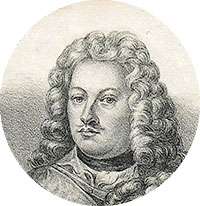Axel Erik Roos

Axel Erik Roos (1684 in Årnäs in Västergötland – December 14, 1765 in Lövåsen, Gestad, Dalsland, Sweden) was a baron, lieutenant general in the Swedish army of Charles XII of Sweden, and governor of Dalsland.[1]
Career
Roos started as a 16-year-old page at the court of Charles XII in 1700, then accompanied the king during the Great Northern War and participated in a number of battles. He was wounded at Kliszów and Fraustadt, was appointed second lieutenant in the Södermanland regiment and, in 1707, lieutenant in the Närke-Värmland regiment. He was appointed to the ”corps of Drabants” in 1708 and accompanied the king to Bendery. There he excelled himself being cited for brilliant bravery in the skirmish at Bender and saved the king's life three times in one day, including protecting the king with his own body. Roos gave a detailed account of the skirmish at Bender in a letter which he personally delivered to the Swedish Queen Ulrika Eleonora. The account was printed in 1757 and has since been reprinted on several occasions. The letter is considered to have great historical value and the original is kept in the National Archives of Sweden.
Roos was appointed Adjutant General in 1713 and on the very same day as colonel in the South Scanian cavalry. Over the following years, Roos was employed by the king in several demanding and secret missions. During one such trip in 1716, he was captured by the Danish enemy, but managed to escape to Scania. He also participated in the 1718 siege of the Fredriksten fortress in Norway, during which the king was killed. Roos was wounded 16 times in the Great Northern War campaign. The king had great confidence in him and called him "Roosen", and he was almost always in the king's immediate proximity during the war.
In 1725 he was promoted to major general and colonel of the Nyland cavalry brigade and the Tavastehus dragoons. In 1728, he was instead given command of the Bohus dragoons. In 1740, after a stint as military commander, he was appointed governor of Älvsborg County, finally retiring as a Lieutenant General. He lived at Lövås manor and died there, 81 years old, in 1766. His funeral assembled a large number of the most prominent nobles in the country. There, his life was described in a long speech by the member of parliament for Värmland, Lennart Magnus Uggla. The speech was distributed in printed form with the title: "Åminnelsetal öfver General, landshöfdingen mm Baron Axel Erik Roos."
It is considered that the man "Axel" in Esaias Tegnér's eponymous poem is Erik Axel Roos. The noble house of Roos came to an end with his death. Roos' sword and spurs were stored for nearly two hundred years in the church of Gestad until they were stolen in the 1980s during a burglary. They have not been recovered since.
Personal life
Axel Roos was the son of General Carl Gustaf Roos and is known among other things, for his command of an infantry unit during the battle of Poltava. Two of his sons were killed serving as officers during campaigns in Poland and Germany. It is said that Erik Axel Roos was not tall and that he kept his youthful looks to the end of his life. There are several paintings of him, including one in Karlberg Palace, Stockholm.
References
- ↑ Roos, 1. Karl Gustaf in Nordisk familjebok, vol. 23 (1916)